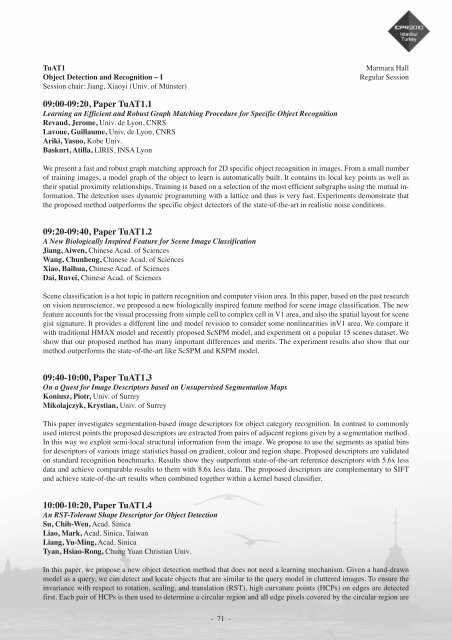Abstract book (pdf) - ICPR 2010
Abstract book (pdf) - ICPR 2010
Abstract book (pdf) - ICPR 2010
- TAGS
- abstract
- icpr
- icpr2010.org
You also want an ePaper? Increase the reach of your titles
YUMPU automatically turns print PDFs into web optimized ePapers that Google loves.
TuAT1 Marmara Hall<br />
Object Detection and Recognition – I Regular Session<br />
Session chair: Jiang, Xiaoyi (Univ. of Münster)<br />
09:00-09:20, Paper TuAT1.1<br />
Learning an Efficient and Robust Graph Matching Procedure for Specific Object Recognition<br />
Revaud, Jerome, Univ. de Lyon, CNRS<br />
Lavoue, Guillaume, Univ. de Lyon, CNRS<br />
Ariki, Yasuo, Kobe Univ.<br />
Baskurt, Atilla, LIRIS, INSA Lyon<br />
We present a fast and robust graph matching approach for 2D specific object recognition in images. From a small number<br />
of training images, a model graph of the object to learn is automatically built. It contains its local key points as well as<br />
their spatial proximity relationships. Training is based on a selection of the most efficient subgraphs using the mutual information.<br />
The detection uses dynamic programming with a lattice and thus is very fast. Experiments demonstrate that<br />
the proposed method outperforms the specific object detectors of the state-of-the-art in realistic noise conditions.<br />
09:20-09:40, Paper TuAT1.2<br />
A New Biologically Inspired Feature for Scene Image Classification<br />
Jiang, Aiwen, Chinese Acad. of Sciences<br />
Wang, Chunheng, Chinese Acad. of Sciences<br />
Xiao, Baihua, Chinese Acad. of Sciences<br />
Dai, Ruvei, Chinese Acad. of Sciences<br />
Scene classification is a hot topic in pattern recognition and computer vision area. In this paper, based on the past research<br />
on vision neuroscience, we proposed a new biologically inspired feature method for scene image classification. The new<br />
feature accounts for the visual processing from simple cell to complex cell in V1 area, and also the spatial layout for scene<br />
gist signature. It provides a different line and model revision to consider some nonlinearities inV1 area. We compare it<br />
with traditional HMAX model and recently proposed ScSPM model, and experiment on a popular 15 scenes dataset. We<br />
show that our proposed method has many important differences and merits. The experiment results also show that our<br />
method outperforms the state-of-the-art like ScSPM and KSPM model.<br />
09:40-10:00, Paper TuAT1.3<br />
On a Quest for Image Descriptors based on Unsupervised Segmentation Maps<br />
Koniusz, Piotr, Univ. of Surrey<br />
Mikolajczyk, Krystian, Univ. of Surrey<br />
This paper investigates segmentation-based image descriptors for object category recognition. In contrast to commonly<br />
used interest points the proposed descriptors are extracted from pairs of adjacent regions given by a segmentation method.<br />
In this way we exploit semi-local structural information from the image. We propose to use the segments as spatial bins<br />
for descriptors of various image statistics based on gradient, colour and region shape. Proposed descriptors are validated<br />
on standard recognition benchmarks. Results show they outperform state-of-the-art reference descriptors with 5.6x less<br />
data and achieve comparable results to them with 8.6x less data. The proposed descriptors are complementary to SIFT<br />
and achieve state-of-the-art results when combined together within a kernel based classifier.<br />
10:00-10:20, Paper TuAT1.4<br />
An RST-Tolerant Shape Descriptor for Object Detection<br />
Su, Chih-Wen, Acad. Sinica<br />
Liao, Mark, Acad. Sinica, Taiwan<br />
Liang, Yu-Ming, Acad. Sinica<br />
Tyan, Hsiao-Rong, Chung Yuan Christian Univ.<br />
In this paper, we propose a new object detection method that does not need a learning mechanism. Given a hand-drawn<br />
model as a query, we can detect and locate objects that are similar to the query model in cluttered images. To ensure the<br />
invariance with respect to rotation, scaling, and translation (RST), high curvature points (HCPs) on edges are detected<br />
first. Each pair of HCPs is then used to determine a circular region and all edge pixels covered by the circular region are<br />
- 71 -



